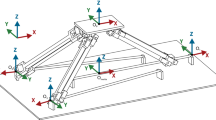Abstract
In order to overcome the exceptional cases of the classical CGK formula for mobility analysis, a novel approach based on intersection of screw manifolds is proposed in this paper. This approach can deal with both the mobility of the moving platform and the full-cycle mobility. Furthermore, this approach can identify the redundant and passive mobilities, and guide the allocation of actuators. The procedure of the intersection operation of screw manifolds is presented in detail using the proposed concept of the complementary screw. And in special conditions, the intersection of two screw manifolds can be achieved instantly without the calculation of complementary screws. Moreover, this approach needs no investigation of the structures and properties of subgroups or submanifolds, and needs no reference to tables that are generalized to demonstrate operational rules for intersection of two subgroups. The proposed notion of the intersection of screw manifolds has the explicit kinematic sense, so that the nature of the mechanical motion of parallel robotic mechanisms can be profoundly understood.
Similar content being viewed by others
References
G. Gogu, Mobility of mechanisms: a critical review, Mechanism and Machine Theory, 40 (2005) 1068–1097.
Z. Huang, J. Liu and D. Zeng, A general methodology for mobility analysis of mechanisms based on constraint screw theory, Science in China Series E -Technological Sciences, 52 (5) (2009) 1337–1347.
J. Zhao, K. Zhou and Z. Feng, A theory of degrees of freedom for mechanisms, Mechanism and Machine Theory, 39 (2004) 621–643.
G. Gogu, Mobility and spatiality of parallel robots revisited via theory of linear transformations, European Journal of Mechanics A–Solids, 24 (2005) 690–711.
J. S. Dai, Z. Huang and H. Lipkin, Mobility of overconstrained parallel mechanisms, ASME Journal of Mechanical Design, 128 (2006) 220–229.
C. Kuo and H. Yan, On the mobility and configuration singularity of mechanisms with variable topologies, ASME Journal of Mechanical Design, 129 (2007) 617–624.
A. Liberati and N. P. Belfiore, A method for the identification of the connectivity in multi-loop kinematic chains: analysis of chains with total and partial mobility, Mechanism and Machine Theory, 41 (2006) 1443–1466.
S. D. Guest and P. W. Fowler, A symmetry-extended mobility rule, Mechanism and Machine Theory, 40 (2005) 1002–1014.
J. Yu, J. S. Dai, T. Zhao, S. Bi and G. Zong, Mobility analysis of complex joints by means of screw theory, Robotica, 27 (2009) 915–927.
T. Yang, A. Liu, Q. Jin, Y. Luo, H. Shen and L. Hang, Position and orientation characteristic equation for topological design of robot mechanisms, ASME Journal of Mechanical Design, 131 (2) (2009) 021001.
A. Müller, Generic mobility of rigid body mechanisms, Mechanism and Machine Theory, 44 (2009) 1240–1255.
D. Yang, J. Xiong and X. Yang, A simple method to calculate mobility with Jacobian, Mechanism and Machine Theory, 43 (2008) 1175–1185.
J. M. Hervé, The plannar-spherical kinematic bond: implementation in parallel mechanisms, http://www.parallemic. org/Reviews/Review013.html (2003).
J. Meng, G. Liu and Z. Li, A geometric theory for analysis and synthesis of sub-6 DOF parallel manipulators, IEEE Transactions on Robotics, 23 (4) (2007) 625–649.
Q. Li and J. M. Hervé, Parallel mechanisms with bifurcation of Schoenflies motion, IEEE Transactions on Robotics, 25 (1) (2009) 158–164.
J. M. Rico, L. D. Aguilera, J. Gallardo, R. Rodriguez, H. Orozco and J. M. Barrera, A more general mobility criterion for parallel platforms, ASME Journal of Mechanical Design, 128 (2006) 207–219.
J. Zhao, Z. Feng and J. Dong, Computation of the configuration degree of freedom of a spatial parallel mechanism by using reciprocal screw theory, Mechanism and Machine Theory, 41 (2006) 1486–1504.
J. Zhao, K. Zhou, D. Mao, Y. Gao and Y. Fang, A new method to study the degree of freedom of spatial parallel mechanisms, International Journal of Advanced Manufacturing Technology, 23 (2004) 288–294.
G. Cheng, W. Gu and S. Ge, Kinematic analysis of a 3SPS+1PS parallel hip joint simulator based on Rodrigues parameters, Journal of Mechanical Science and Technology, 26 (10) (2012) 3299–3310.
D. Gan, J. S. Dai, J. Dias and L. Seneviratne, Constraint-planebased synthesis and topology variation of a class of metamorphic parallel mechanisms, Journal of Mechanical Science and Technology, 28 (10) (2014) 4179–4191.
W. Bu, Closeness to singularities of robotic manipulators measured by characteristic angles, Robotica, Available on CJO 2014 doi:10.1017/S0263574714002823.
Author information
Authors and Affiliations
Corresponding author
Additional information
Recommended by Associate Editor Kyoungchul Kong
Wanghui Bu received the Bachelor’s degree from Tongji University, China, in 2004, and the Ph.D. degree from Zhejiang University, China, in 2009. He is currently an Associate Professor at the School of Mechanical Engineering, Tongji University, China. His current research interests are focused on mechanisms and robotics.
Jing Chen received the Ph.D. degree in Mechanical Engineering from Zhejiang University, China, in 2010. She is now a Lecturer at the School of Computer Science and Technology, Hangzhou Dianzi University, China. Her current research interests include machine learning and urban transportation.
Rights and permissions
About this article
Cite this article
Bu, W., Yan, S., Chen, J. et al. Mobility analysis for parallel manipulators based on intersection of screw manifolds. J Mech Sci Technol 30, 4345–4352 (2016). https://doi.org/10.1007/s12206-016-0849-3
Received:
Revised:
Accepted:
Published:
Issue Date:
DOI: https://doi.org/10.1007/s12206-016-0849-3




